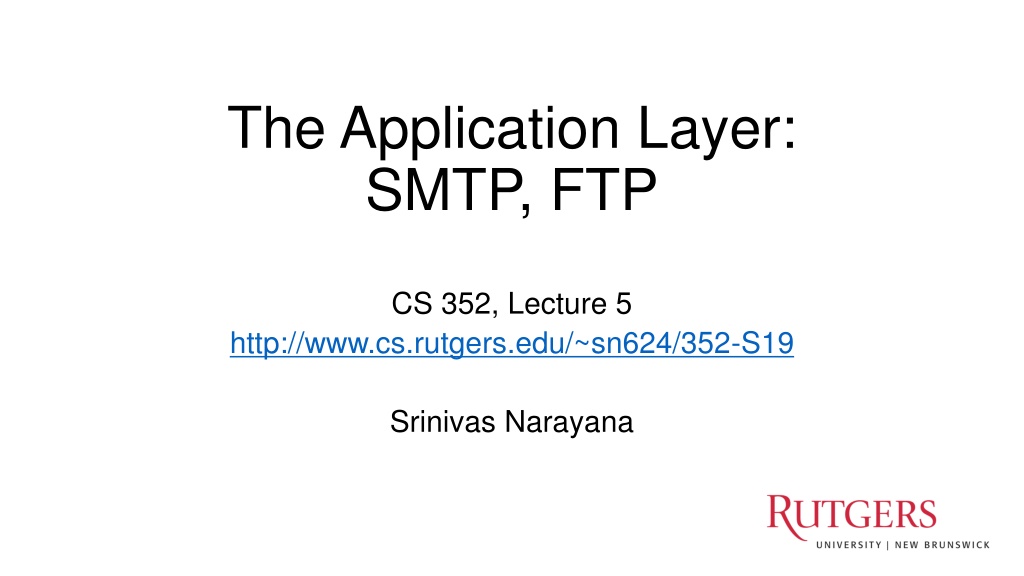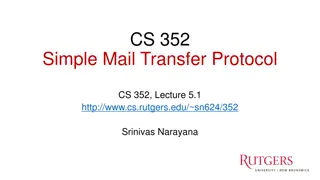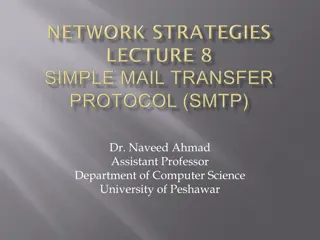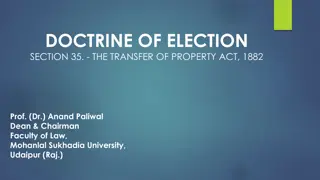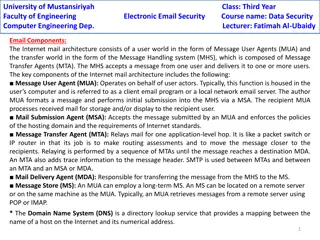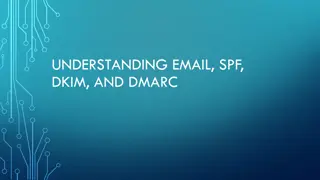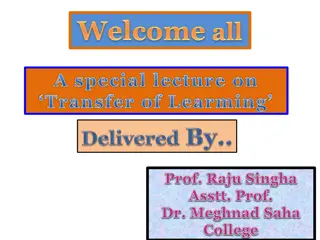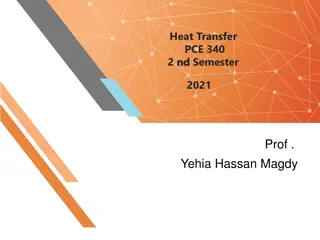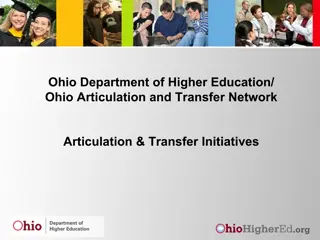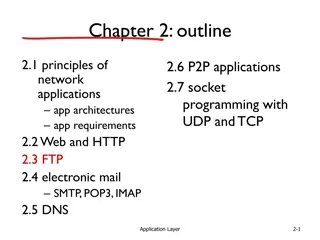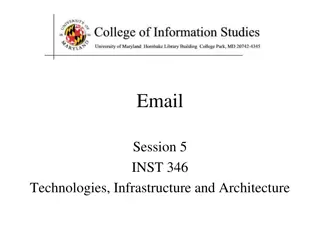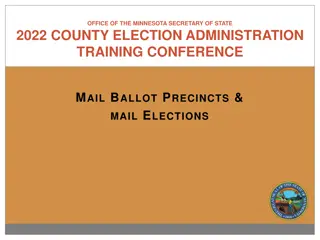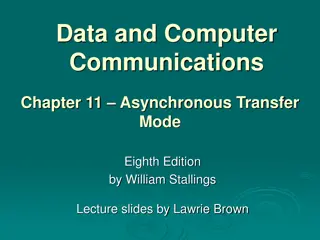Understanding SMTP - Simple Mail Transfer Protocol
SMTP (Simple Mail Transfer Protocol) is a fundamental component of the application layer in computer networks. It is used for sending electronic mail messages between servers and user agents. The process involves user agents composing messages, connecting to mail servers, and transferring messages over TCP connections. SMTP plays a crucial role in the transmission of emails across the internet, ensuring efficient communication between users.
Download Presentation

Please find below an Image/Link to download the presentation.
The content on the website is provided AS IS for your information and personal use only. It may not be sold, licensed, or shared on other websites without obtaining consent from the author. Download presentation by click this link. If you encounter any issues during the download, it is possible that the publisher has removed the file from their server.
E N D
Presentation Transcript
The Application Layer: SMTP, FTP CS 352, Lecture 5 http://www.cs.rutgers.edu/~sn624/352-S19 Srinivas Narayana 1
Recap: Application-layer protocols DNS: lookup a (machine-readable) address using a (human- readable) name? Used by many applications as a building block Recursive lookups for scale and administrative convenience HTTP: Transfer content over the Internet with portability Very familiar to users of the Internet Many, many, applications use HTTP Today: SMTP (email) and FTP (file transfer)
SMTP Simple Mail Transfer Protocol
outgoing Electronic Mail message queue user mailbox user agent Three major components: 1. User agents a.k.a. mail reader e.g., Applemail, Outlook mail server user agent SMTP mail server user agent SMTP Web-based user agents (ex: gmail) SMTP user agent mail server user agent user agent 4
Electronic Mail: Mail servers 2. Mail Servers Mailbox contains incoming messages for user Message queue of outgoing (to be sent) mail messages Sender mail server makes connection to Receiver mail server IP address, port 25 user agent mail server user agent SMTP mail server user agent SMTP SMTP 3. SMTP protocol Used to send messages Client: sending user agent or sending mail server server: receiving mail server user agent mail server user agent user agent 5
Scenario: Alice sends message to Bob 1) Alice uses UA to compose message and to bob@someschool.edu 2) Alice s UA sends message to her mail server; message placed in message queue 3) Client side of SMTP opens TCP connection with Bob s mail server 4) SMTP client sends Alice s message over the TCP connection 5) Bob s mail server places the message in Bob s mailbox 6) Bob invokes his user agent to read message 1 mail server mail server 3 user agent user agent 2 6 4 5 6
Sample SMTP interaction 220 hill.com SMTP service ready HELO town.com MAIL FROM: <jack@town.com> RCPT TO: <jill@hill.com> DATA Jill, I m not feeling up to hiking today. Will you please fetch me a pail of water? . 250 message accepted QUIT 221 hill.com closing connection 250 hill.com Hello town.com, pleased to meet you 250 <jack@town.com> Sender ok 250 <jill@hill.com> Recipient ok 354 Enter mail, end with . on a line by itself 7
Mail message (stored on server) format SMTP: protocol for exchanging email msgs RFC 822: standard for text message format: header blank line header lines, e.g., To: From: Subject: different from SMTP commands! (these would still be under DATA ) body body the message , ASCII characters only 9
Message format: multimedia extensions MIME: multimedia mail extension, RFC 2045, 2056 additional lines in msg header declare MIME content type From: alice@crepes.fr To: bob@hamburger.edu Subject: Picture of yummy crepe. MIME-Version: 1.0 Content-Transfer-Encoding: base64 Content-Type: image/jpeg MIME version method used to encode data multimedia data type, subtype, parameter declaration base64 encoded data ..... ......................... ......base64 encoded data encoded data 10
Mail access protocols POP3 or IMAP4 SMTP SMTP access protocol user agent user agent receiver s mail server sender s mail server Why not use SMTP here? SMTP: delivery/storage to receiver s server Mail access protocol: retrieval from server POP: Post Office Protocol [RFC 1939] Client connects to POP3 server on TCP port 110 IMAP: Internet Mail Access Protocol [RFC 1730] Client connects to TCP port 143 HTTP: gmail, Yahoo! Mail, etc. Why do we need a sender side mail server? 11
POP vs IMAP POP3 Stateless server UA-heavy processing UA retrieves email from server, then typically deleted from server Latest changes are at the UA Simple protocol (list, retr, del within a POP session) IMAP4 Stateful server UA and server processing Server sees folders, etc. which are visible to UAs Changes visible at the server Complex protocol 12
What about web-based email? Connect to mail servers via web browser Ex: gmail, outlook, etc. Browsers speak HTTP Email servers speak SMTP Need a bridge to retrieve email using HTTP! 13
Web based email HTTP server HTTP server SMTP Client SMTP server Internet 14
Comparing SMTP with HTTP HTTP: pull SMTP: push both have ASCII command/response interaction, status codes HTTP: each object encapsulated in its own response msg SMTP: multiple objects sent in multipart msg HTTP: can put non-ASCII data directly in response SMTP: need ASCII-based encoding! 15
FTP File Transfer Protocol
Client server connection DNS Host name IP Address ftp commands Data transfer, port 20 20
FTP: the file transfer protocol file transfer FTP user interface FTP client FTP server user at host remote file system local file system transfer file to/from remote host client/server model client: side that initiates transfer (either to/from remote) server: remote host ftp: RFC 959 ftp server: port 21, port 20 (data connection) 21
FTP: separate control & data connections out of band control Control connection: Authorization Directory browse Commands Data connection Transfer files FTP server maintains state : current directory, earlier authentication TCP control connection port 21 TCP data connection port 20 FTP client FTP server 22
FTP commands, responses Sample commands sent as ASCII text over control channel USER username PASS password LISTreturn list of file in current directory RETR filenameretrieves (gets) file STOR filenamestores (puts) file onto remote host Sample return codes status code and phrase (as in HTTP) 331 Username OK, password required 125 data connection already open; transfer starting 425 Can t open data connection 452 Error writing file 23
FTP Active connection Data connection initiated from the server Client opens a connection from port x for sending commands to server port 21 Server opens a connection from port 20 to send data at port x+1 24
FTP passive connection (always client initiated) Connections always initiated from the client Client opens a connection from port x for sending commands to server port 21 Client sends a request for PASSIVE connection with PASV command Server replies with a new port number Sp on which it is listening Client opens a connection from port x+1 to server port Sp 25
Problems with FTP Sends passwords in plain ASCII text Eavesdropper can recover passwords Fatal flaw, turned off at a lot of sites Replaced with scp, sftp instead 26
Recall the Internet protocol stack Application FTP HTTP HTTPS SMTP DNS Transport UDP TCP IP Network X.25 802.11 ATM Host-to-Net
Themes from application-layer protocols Request/response nature of protocols Headers determine the actions of all the parties of the protocol Separation of concerns: Examples: Content rendering for users (browser, UA) separated from protocol ops (mail server) Reliable mail reception: Retrieve email at an always on receiver mail server Reliable mail sending: Send mail using a different machine rather than UA In-band vs. out-of-band control: SMTP+HTTP vs. FTP Q: How are commands recognized as distinct from data? Keep it simple until you really need complexity Examples: ASCII-based design; stateless servers IMAP for email organization Secure extensions for FTP and HTTP 28
Next: Transport Application FTP HTTP HTTPS SMTP DNS Transport UDP TCP IP Network X.25 802.11 ATM Host-to-Net
